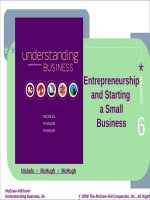Understanding business 11th by mchugh nickels chap013
Bạn đang xem bản rút gọn của tài liệu. Xem và tải ngay bản đầy đủ của tài liệu tại đây (6.1 MB, 54 trang )
CHAPTER 13
Marketing:
Helping
Buyers Buy
McGraw-Hill/Irwin
Copyright © 2015 by the McGraw-Hill Companies, Inc. All rights reserved.
LEARNING OBJECTIVES
1. Define marketing, and apply the marketing concept
to both forprofit and nonprofit organizations.
2. Describe the four P’s of marketing.
3. Summarize the marketing research process.
13-2
LEARNING OBJECTIVES
4. Show how marketers use environmental scanning to
learn about the changing marketing environment.
5. Explain how marketers apply the tools of market
segmentation, relationship marketing and the study
of consumer behavior.
6. Compare the businesstobusiness market and the
consumer market.
13-3
DAYMOND JOHN
FUBU
• Started sewing wool hats in his
apartment in 1989 and sold
them on the street.
• He started designing other
products and created the brand
FUBU.
• After many rocky years, John
has earned millions and advises
others on Shark Tank.
13-4
NAME that COMPANY
This company studies population growth and
regional trends as it expands its product line for
specific regions of the country. Its research led
to the creation of Creole flavors targeted
primarily in the South and spicy nacho chees
flavors mad especially for Texas and California.
Name that company!
13-5
WHAT’S MARKETING?
LO 131
• Marketing The activity, set of institutions and
processes for creating, communicating, delivering,
and exchanging offerings with value for customers,
clients, partners, and society at large.
13-6
FOCUS of CONTEMPORARY
MARKETING
LO 131
• Marketing today involves helping the buyer buy
through:
- Websites that help buyers find the best price,
identify product features, and question sellers.
- Blogs and social networking sites that cultivate
consumer relationships.
13-7
FOUR ERAS of U.S. MARKETING
LO 131
• Production Era
• Selling Era
• Marketing Concept Era
• Customer Relationship
Era
13-8
The PRODUCTION and
SELLING ERAS
LO 131
• The general philosophy
was “Produce what you
can because the market
is limitless.”
• After mass production,
the focus turned from
production to persuasion.
13-9
The MARKETING CONCEPT ERA
LO 131
• After WWII, a consumer spending boom
developed.
• Businesses knew they needed to be responsive
to consumers if they wanted their business.
13-10
APPLYING the
MARKETING CONCEPT
LO 131
• The Marketing Concept includes three parts:
1. Customer Orientation Finding out what
customers want and then providing it.
2. Service Orientation Making sure everyone in
an organization is committed to customer
satisfaction.
3. Profit Orientation Focusing on the goods and
services that will earn the most profit.
13-11
The CUSTOMER
RELATIONSHIP ERA
LO 131
• Customer Relationship Management (CRM)
Learning as much as you can about customers and
doing what you can to satisfy or exceed their
expectations.
• Organizations seek to enhance customer
satisfaction building longterm relationships.
• Today firms like Priceline and Travelocity use
CRM that allow customers to build a relationship
with the suppliers.
13-12
The EMERGING
MOBILE MARKETING ERA
LO 131
• As digital technology continues to grow,
consumer demands are expected to rise in:
1. Now: Consumers want to interact anywhere, anytime.
2. Can I?: They want to use information in new ways
that create value for them.
3. For me: Consumers expect personalized
experiences.
4. Simply: Consumers want all interactions to be easy.
13-13
SERVICE with a SMILE
LO 131
Six Steps for Keeping Your Customers Happy
• The cost of acquiring a new customer is 5x the
cost of retaining one. Here’s how to keep them:
1. Build trust
2. Emphasize the long term
3. Listen
4. Treat your customers like stars
5. Show appreciation
6. Remember employees are
customers too!
Source: Inc. Guidebook, Vol. 2 No. 5.
13-14
MAKING SUSTAINABILITY
JUST PEACHY
• Campbell Soup is one of the
100 Most Sustainable
Corporations in the World.
• They work with local farmers
in New Jersey to use peaches
unfit for purchase.
• Campbell’s manufactures
peach salsa at no cost and
donates proceeds to the Food
Bank of South Jersey.
13-15
NONPROFIT MARKETING
LO 131
• Nonprofit marketing tactics include:
- Fundraising
- Public Relations
- Special Campaigns
- Ecological practices
- Changing public opinions and
attitudes
- Increasing organizational
membership
13-16
MARKETING STRATEGIES for
NONPROFITS
LO 131
• Nonprofit marketing strategies include:
- Determine the firm’s goals and objectives
- Focus on longterm marketing
- Find a competent board of directors
- Exercise strategic planning
- Train and develop longterm volunteers
- Carefully segment the target market
13-17
The FOUR P’s
LO 132
13-18
DEVELOPING a PRODUCT
LO 132
• Product A good, service, or idea that satisfies a
consumer’s want or need.
• Test Marketing Testing
product concepts among
potential product users.
• Brand Name A word,
letter, or a group of words or
letters that differentiates one
seller’s goods from a
competitor’s.
13-19
PRICING and
PLACING a PRODUCT
LO 132
• Pricing products depends on many factors:
- Competitors’ prices
- Production costs
- Distribution
- High or low price strategies
• Middlemen are important in place strategies
because getting a product to consumers is
critical.
13-20
PROMOTING the PRODUCT
LO 132
• Promotion All the techniques sellers use to inform
people about their products and motivate them to
purchase those products.
• Promotion includes:
- Advertising
- Personal selling
- Public relations
- Word of mouth
- Sales promotions
Photo Courtesy of: Uri Baruchin
13-21
PERFECT PROMOTION
LO 132
How to Get Customers to Need Your Product
• Get customers emotional about your product:
- Make your product “built to love.”
- Use emotionladen advertising.
• Be a likeable salesperson:
- Have confidence.
- Be intriguing.
- Show interest in others.
- Be enthusiastic and
respectful.
Sources: Entrepreneur, www.entrepreneur.com, accessed November 2014.
13-22
TANGLED WEB of PROMOTION
LO 132
Seven Sins of Web Design
• Too much clutter
• Too difficult to navigate
• Stale information
• Copycatting
• Ignoring the needs of your
customer base
Photo Creditf: Cortes de Cima
• Not analyzing data
• Refusing to get outside help
Source: Entrepreneur, www.entrepreneur.com, accessed November 2014.
13-23
TEST PREP
• What does it mean to “help the buyer buy?”
• What are the three parts of the marketing
concept?
• What are the Four P’s of the Marketing Mix?
13-24
SEARCHING for INFORMATION
LO 133
• Marketing Research Analyzing markets to
determine challenges and opportunities, and finding
the information needed to make good decisions.
• Research is used to identify products consumers
have used in the past and what they want in the
future.
• Research uncovers market trends and attitudes
held by company insiders and stakeholders.
13-25









